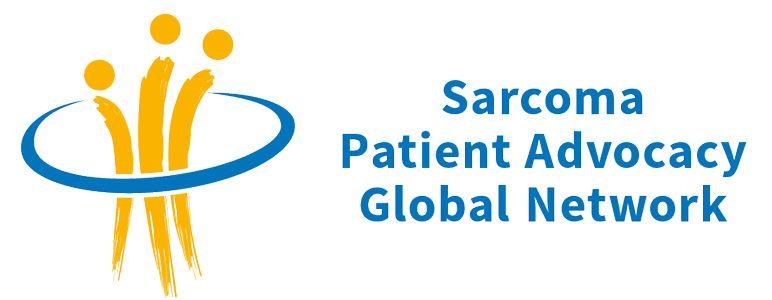My lumpy life as a young adult
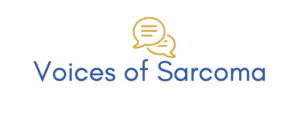
A journey with sarcoma and making the most out of life
by Matt Sha
After a shower, I noticed an odd lump on my left hip. There was no pain, so I didn’t think much about it. I thought, “It’s probably just a swollen bruise from playing basketball. I’ll give it two weeks and see if it’s still there.” Two weeks passed, but Lumpy—the name I declared this mysterious lump—remained. I figured I should schedule an appointment with my family doctor since my countless health sciences courses had drilled a “when in doubt, check it out” mentality in me.
I’m glad I took those classes.
At the doctor’s appointment, I was told that Lumpy was likely a lipoma (a lump of fat) that was benign (harmless). Fortunately, I was referred for an ultrasound. After weeks of waiting, my scan results recommended an MRI. A couple more weeks passed, and I was referred for a biopsy at the local cancer centre for suspicion of soft tissue sarcoma. On a gloomy November day in 2021, I received a phone call during work, and my oncologist diagnosed me with myxoid liposarcoma.
Reckoning with a cancer diagnosis
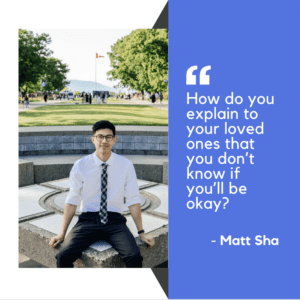 I had no idea what myxoid or liposarcoma meant, so I didn’t want to overreact. But when I began googling about my cancer in hopes of learning more, the only video I saw on YouTube featured a young patient who had had their leg amputated. Every research article I found about my cancer was full of percentages detailing the probability of my survival, which felt like analyzing mathematical equations that would determine whether I would ever get to graduate with my science degree, become a doctor, or cross off my bucket list items like skydiving. Supposedly, sarcoma was extremely rare, especially for my age. It seemed that I had won the lottery, but this lottery was not the type where you win generational wealth or a bright pink car.
I had no idea what myxoid or liposarcoma meant, so I didn’t want to overreact. But when I began googling about my cancer in hopes of learning more, the only video I saw on YouTube featured a young patient who had had their leg amputated. Every research article I found about my cancer was full of percentages detailing the probability of my survival, which felt like analyzing mathematical equations that would determine whether I would ever get to graduate with my science degree, become a doctor, or cross off my bucket list items like skydiving. Supposedly, sarcoma was extremely rare, especially for my age. It seemed that I had won the lottery, but this lottery was not the type where you win generational wealth or a bright pink car.
It was hard enough to understand what my diagnosis meant, but then I had to tell my family and friends about it. How do you explain to your loved ones that you don’t know if you’ll be okay.
My experience with surgery
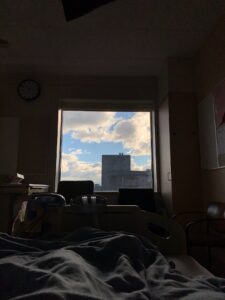
The view of blue skies from my hospital bed during recovery
I had surgery the following January after spending my holidays exercising daily to prepare myself for the worst-case scenario of my surgery. Basketball has been a big part of my life, and suddenly, there was a possibility I could never play again. In short, the surgery consisted of cutting out the tumour in my hip, leaving behind a crater (a cancer battlefield) and taking skin from my outer thigh to perform a skin graft that would grow to cover the abyss that would be my hip. Although I was told I would be back to work after taking just one week off, I spent a week at the hospital and three months recovering at home from a skin graft that would grow to cover the abyss that would be my hip.
Recovery was a huge mental battle for me. I felt a lack of control for the first time. There was no option of studying harder or running faster to improve the situation. I was scared that my wound was not healing. I feared every night I would bleed out from my skin graft after having fainted in the hospital from blood loss on my fourth day of recovery. I got frustrated at my inability to walk, care for myself, and go to work and class like other students after seeing my friends on social media attending exciting events. I felt like a burden to my family that cooked for me, changed the bandages on my wounds, and put up with my daily whining.
Another patient recently told me that with cancer, there are always two patients: You and the person taking care of you. We do not often talk about the stress and anxiety that caretakers experience alongside us.
Another thing to worry about as a young adult
Until now, I have not mentioned the context of my life during my cancer journey. I was diagnosed with cancer between my third and fourth year of university while I was on a work term. 21 years old is when most people begin to figure out life. Most of us are occupied with struggling in school, finding a suitable career, developing and maintaining friendships and romantic relationships, affording rent and the rising costs of living, battling mental health problems like depression and anxiety, and the list goes on. And trust me, it goes on for a long time. No longer is anyone holding your hand.
Now add on cancer, a full-time job of anxiety and overwhelm and spending your afternoons calling health centres to book crucial scan appointments that have been mysteriously delayed. I have a 30-page document where I track every little detail my oncologist and other healthcare staff mentioned, reports filled with scientific jargon, and a list of available resources just in case. Did I mention that no one thinks you are a patient when you enter your centre? Given the average age of cancer patients is three times my age, traversing through the cancer centre always leaves me feeling out of place. These moments of reflection, sitting in a dull waiting room preparing to potentially hear a life-altering update, gave me an immense appreciation for staying grounded in the moment.
Reclaiming and connecting with my story
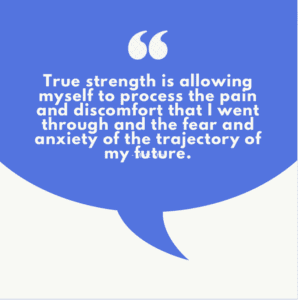 At the time that this blog is being posted, I am healthy and cancer-free. My surgery back in early 2022 went as planned, and I will continue to attend appointments for scans for 10 years. However, there will always be a chance that Lumpy will come back into my life at any time. I know that I should try to celebrate the fact that I am cancer-free more often; however, I feel guilty about having recovered and not having undergone radiation or chemotherapy and maintaining my mobility.
At the time that this blog is being posted, I am healthy and cancer-free. My surgery back in early 2022 went as planned, and I will continue to attend appointments for scans for 10 years. However, there will always be a chance that Lumpy will come back into my life at any time. I know that I should try to celebrate the fact that I am cancer-free more often; however, I feel guilty about having recovered and not having undergone radiation or chemotherapy and maintaining my mobility.
Reckoning with the vast scenarios and outcomes is a unique aspect of the sarcoma experience because every sarcoma is so different, and due to its rarity, you may not know someone with the same diagnosis or experience as you, which can be isolating. After joining an adolescent and young adult (AYA) support group and sharing my stories, I realized I had been pushing down my fear and discomfort so that the people in my life did not worry about me.
True strength is allowing myself to process the pain and discomfort that I went through and the fear and anxiety of the trajectory of my future. Every conversation—the light-hearted ones joking about the bad hand we were dealt and the heavy ones about the nights I cried myself to sleep in discomfort—gives me more control of my story.
Being diagnosed with a sarcoma is similar to skydiving

Skydiving in Oahu after recovering from my surgery
What happened with my bucket list? Well, when I was back on my feet, I decided to check off the item at the top: Skydiving.
The moment right when you jump out of the plane at 14,000 feet in the air encapsulates part of the cancer experience. You no longer have control of the outcome. You need to trust the individuals caring for you, such as the skydive instructor who has jumped thousands of times. It is scary, but having properly trained staff, being aware of the risks, and ongoing research into how to make the process reliable and controlled make it safer. Checking the gear early, often, and with multiple sets of eyes is one of the main ways skydivers ensure their risks are reduced.
Similarly, this strategy applies to sarcoma. Early detection and diagnosis of suspicious lumps significantly improve the outcomes.
Making a difference where I can through patient advocacy
I looked for a way to give back to the system and communities that took care of me. After hearing about an opportunity to become a patient partner at my cancer centre, I got involved. In the following months, I was involved with providing feedback about my local cancer centre, editing patient handouts describing diagnoses and treatments and sharing my story with leaders of my healthcare system. My cancer centre is committed to patient-centred care, rooted in the philosophy that there should be “Nothing about patients without patients.”
I hope that sarcoma patients around the world will receive the care and have access to the resources that they need to be treated for their disease, maintain their well-being, and get connected to others who have gone through a similar experience.
Photos: Courtesy of Matt Sha
Bio:
Matt Sha (He/him) is a patient partner with the British Columbia Cancer Patient and Family Experience Program in Canada and has lived experience with myxoid liposarcoma. After graduating from the University of British Columbia (UBC) with a Bachelor of Science in 2023, he works for the UBC Men’s Health Research Program. He is passionate about health promotion, actively advocating for patient-centred care for adolescents and young adults (AYAs) with cancer by collaborating on quality improvement engagements and sharing his personal story.
